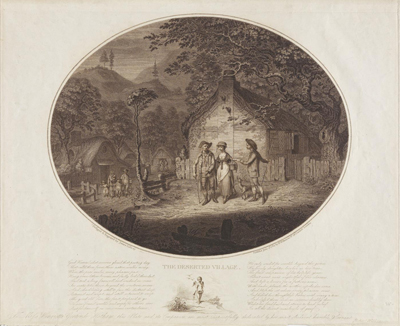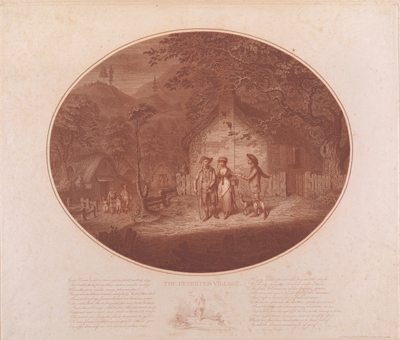The Deserted Village*
Like its companion, The Village Train, with the same publication date of June 4th, 1784, the same dedication to Henrietta Gertrude Hotham (1753-1816) and the same signature line, this print is based on lines taken from Oliver Goldsmith's pastoral lament, The Deserted Village (1770). In this case, the lines and image portray the sorrow of one family (among others) as they are forced to leave the village so lovingly characterized in The Village Train.

© Lewis Walpole Library, Yale University
Like The Village Train, The Deserted Village demonstrates Gillray's command of the stipple engraving technique of Francesco Bartolozzi who was a member of the Royal Academy schools while Gillray was a student there, and the overall influence of rococo painting in the overhanging tree. And it also displays Gillray's signature strength in the carefully considered design of the image. The three figures of father, daughter, and lover are nicely encapsulated by the pitched roof of the house behind them. And the importance of the daughter to both father and lover is suggested by her location between them and in front of the chimney, the hearth being the center of every home. The painful choice the daughter is making is subtly suggested by the physical space between the figures—the daughter's arm now linked with her father while her hand is extended to her lover whose eyes she cannot meet. In front of all of them, both literally and figuratively, the shadows begin.
To the left, other dispossessed families make their way along the road next to a starved tree. The rounded roofs of their emptying houses parallel the rounded hills behind them suggesting an organic and completely natural relationship between their rural life and the rural landscape they are leaving.
This is not the only version of the plate. There is another, clearly later version in the Beinecke Library which is missing the conspicuous dedication by Robert Wilkinson, the printseller, to Miss Henrietta Gertrude Hotham, and the signature line, "Design'd & Engrav'd by James Gillray." And instead of the carefully lettered publication line around the print oval, a crude publication line has been scratched into the lower right hand corner of the print. Why?

© Beinecke Rare Book and Manuscript Library, Yale University
One explanation is that the dedication of the two original prints to Miss Hotham (1753-1816), the only child of the Baronet Sir Charles Hotham and heiress to the estate of Lady Suffolk, was likely an attempt by Wilkinson to gain a patron for future work. When that plan failed to bear fruit, he would probably have wanted to remove the dedication as an obstacle to its sale to a wider audience who knew and loved Goldsmith's poem. And by 1786, through prints like Wife & No Wife, or a Trip to the Continent, and The Morning after Marriage, or a Scene on the Continent for William Holland, Gillray was already gaining a reputation for prints of a quite different nature. Wilkinson might have felt that Gillray's signature line would have created the wrong associations.
* This is a revision of my earlier commentary on this print before noticing the differences between the Lewis Walpole Library version and the British Museum and Beinecke Library versions. Thanks to David Alexander for prompting the revision and correcting my assumption that Gillray may have been a student of Bartolozzi's.
Sources and Reading
- Draper Hill, Mr. Gillray The Caricaturist, 1965, pp. 26-29
- Oliver Goldsmith, Full text of "The Deserted Village," Bartleby.com
- "The Deserted Village," Wikipedia
Comments & Corrections
NOTE: Comments and/or corrections are always appreciated. To make that easier, I have included a form below that you can use. I promise never to share any of the info provided without your express permission.